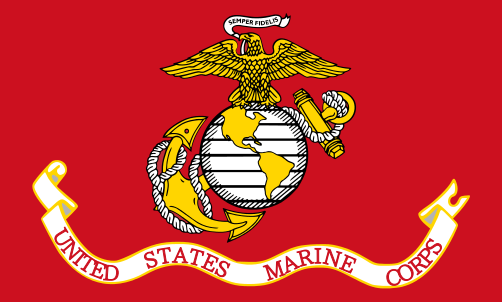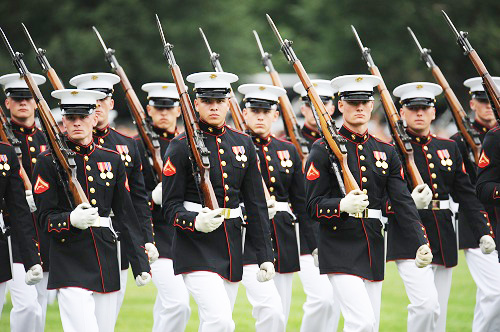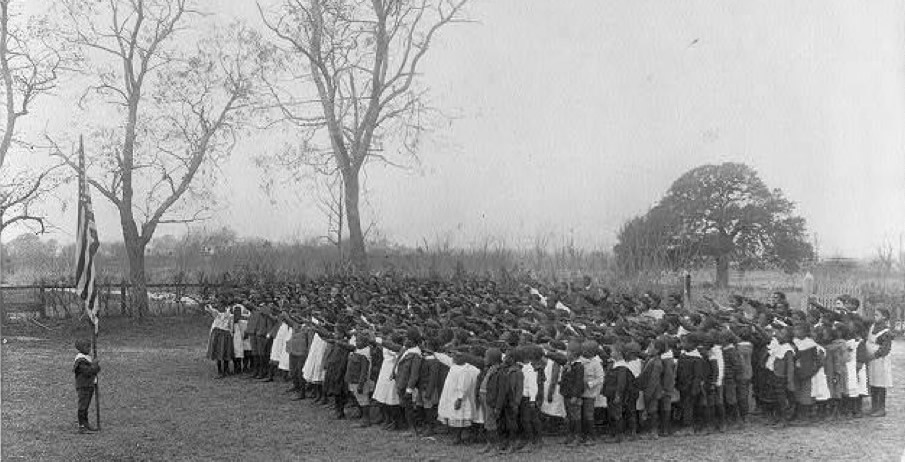
The Iwo Jima Memorial, Washington, D.C.
Over
one hundred students and chaperones piled off the buses and headed
towards the Memorial. I noticed a solitary figure at the base of
the statue, and as I got closer he asked, "Where are you guys
from?"
I told him that we were from Wisconsin. "Hey, I'm a cheese
head, too! Come gather around, cheese heads, and I will tell you
a story."
Note: James Bradley just happened to be in Washington, D.C., to
speak at the Memorial the following day. He was there that night
to say good night to his dad, who has since passed away. He was
just about to leave when he saw the buses pull up. I videotaped
him as he spoke to us, and received his permission to share what
he said from my videotape. It is one thing to tour the incredible
monuments filled with history in Washington, D.C., but it is quite
another to get the kind of insight we received that night.
When all had gathered around, he reverently began to speak. Here
are his words from that night.
"My name is James Bradley and I'm from Antigo, Wisconsin. My
dad is on that statue, and I just wrote a book called "Flags
of Our Fathers", which is number 5 on the New York Times Best
Seller list, right now. It is the story of the six boys you see
behind me.
"Six boys raised the flag. The first guy putting the pole in
the ground is Harlon Block. Harlon was an all-state football player.
He enlisted in the Marine Corps with all the senior members of his
football team. They were off to play another type of game. A game
called "War." But it didn't turn out to be a game.

A war weary face on Iwo Jima.
Harlon,
at the age of 21, died with his intestines in his hands. I don't
say that to gross you out, I say that because there are people who
stand in front of this statue and talk about the glory of war. You
guys need to know that most of the boys on Iwo Jima were 17, 18,
and 19 years old.
He pointed to the statue. "You see this next guy? That's Rene
Gagnon from New Hampshire. If you took Rene's helmet off at the
moment this photo was taken and looked in the webbing of that helmet,
you would find a photograph ... a photograph of his girlfriend.
Rene put that in there for protection because he was scared. He
was 18 years old. Boys won the battle of Iwo Jima. Boys. Not old
men.
"The next guy here, the third guy in this tableau, was Sergeant
Mike Strank. Mike is my hero. He was the hero of all these guys.
They called him the "old man" because he was so old. He
was already 24. When Mike would motivate his boys in training camp,
he didn't say, 'Let's go kill some Japanese' or 'Let's die for our
country.' He knew he was talking to boys. Instead he would say,
'You do what I say, and I'll get you home to your mothers.'
"The last guy on this side of the statue is Ira Hayes, a Pima
Indian from Arizona. Ira Hayes walked off Iwo Jima. He went into
the White House with my dad. President Truman told him, 'You're
a hero.' He told reporters, 'How can I feel like a hero when 250
of my buddies hit the island with me and only 27 of us walked off
alive?' So take your class at school, 250 of you spending a year
together having fun, doing everything together. Then all 250 of
you hit the beach, but only 27 of your classmates walk off alive.
That was Ira Hayes. He had images of horror in his mind. Ira Hayes
died dead drunk, face down at the age of 32, ten years after this
picture was taken.
"The next guy, going around the statue, is Franklin Sousley
from Hilltop, Kentucky. A fun-lovin' hillbilly boy. His best friend,
who is now 70, told me, 'Yeah, you know, we took two cows up on
the porch of the Hilltop General Store. Then we strung wire across
the stairs so the cows couldn't get down. Then we fed them Epsom
salts. Those cows crapped all night. Yes, he was a fun-lovin' hillbilly
boy. Franklin died on Iwo Jima at the age of 19. When the telegram
came to tell his mother that he was dead, it went to the Hilltop
General Store. A barefoot boy ran that telegram up to his mother's
farm. The neighbors could hear her scream all night and into the
morning. The neighbors lived a quarter of a mile away.
"The next guy, as we continue to go around the statue, is my
dad, John Bradley from Antigo, Wisconsin, where I was raised. My
dad lived until 1994, but he would never give interviews. When Walter
Cronkite's producers, or the New York Times would call. We were
trained as little kids to say, 'No, I'm sorry, sir, my dad's not
here. He is in Canada fishing. No, there is no phone there, sir.
No, we don't know when he is coming back.'
"My
dad never fished or even went to Canada. Usually, he was sitting
there right at the table eating his Campbell's soup. But we had
to tell the press that he was out fishing. He didn't want to talk
to the press.

When
the public first demanded this stamp commemorating the Flag
Raising on Iwo Jima, the U.S. Post Postal Service initially rejected
the
idea out of hand. "No living person(s) can appear on a U.S.
stamp,"
they replied. But the public demand was so great that the Congress
pushed for the stamp. It was issued just five months after the Flag
Raising. On the first day of issue, people stood patiently in lines
stretching for city blocks on a sweltering July day in 1945 for
a chance to buy their beloved stamp. For many years,
this was the biggest selling stamp in the history of the
U.S. Postal Service. Over 137 million were sold.

'The Sands of Iwo Jima' movie premiered in 1949.
From left, Ira Hayes, John Bradley, John Wayne and Rene Gagnon.

This photo was taken on November 10, 1954, the
178th birthday of the United States Marine Corps.
From front left, John Bradley, Rene Gagnon,
Vice Pres. Richard Nixon, and Ira Hayes.
BTW: Ira Hayes died three months later.
"You
see, my dad didn't see himself as a hero. Everyone thinks these
guys are heroes, 'cause they are in a photo and on a monument. My
dad knew better. He was a medic. John Bradley from Wisconsin was
a caregiver. In Iwo Jima he probably held over 200 boys as they
died. And when boys died in Iwo Jima, they writhed and screamed
in pain.
"When I was a little boy, my third grade teacher told me that
my dad was a hero. When I went home and told my dad that, he looked
at me and said, 'I want you always to remember that the heroes of
Iwo Jima are the guys who did not come back. Did NOT come back.'"
"So that's the story about six nice young boys. Three died
on Iwo Jima, and three came back as national heroes. Overall, 7,000
boys died on Iwo Jima in the worst battle in the history of the
Marine Corps. My voice is giving out now, so I will end here. Thank
you for your time." --

 Factoids
Factoids

Iwo
Jima is now known as Iwo
To,
the original Japanese name of the island.
Leadership
training starts on the drill
field
where group consciousness skills emerge;
where the individual me becomes the collective we;
where a leader learns to follow, obey, and command.
My  Sense Sense
By Vince Melito

Vince Melito
"One of the highest spiritual practices I ever did was close order drill at the
3HO Denver ashram. I learned so much about responding over reacting --
about authority over disrespect -- about the other over the self. Thank you,
Hari Singh Bird, the greatest spiritual teacher I ever had." -- Vince Melito
My  Sense Sense
By Hari Singh Bird

Hari Singh BIrd
Sat Nam. Reading the preceding comment is a humbling testimonial for me. Vince is the only person I'm aware of other than myself that experienced spiritual insights while participating in close order drill. Reading his account causes me to reflect on my training and experience with COD in the Marine Corps, and when Yogi Bhajan requested that I go to Phoenix, AZ and San Francisco, CA in the late '70s to lead COD as a part of their morning sadhana just as we were doing at the Denver ashram. I wonder if it's any part of today's 3HO ashram experience. BTW: Yogiji also invited me to teach COD to the women at KWTC. I've often wondered how many understand this technology and its role in teaching leadership skills. |
Semper Fidelis
aka Semper Fi


Semper Fidelis distinguishes the Marine Corps bond from any other.
It goes beyond teamwork—it is a brotherhood that can always be counted
on. Latin for "always faithful," Semper Fidelis became the Marine Corps motto
in 1883. It guides Marines to remain faithful to the mission at hand, to each other,
to the Corps and to country, no matter what. Becoming a Marine is a transformation
that cannot be undone, and Semper Fidelis is a permanent reminder of that. Once
made, a Marine will forever live by the ethics and values of the Corps. In addition to
Semper Fidelis, Marine Corps Officers also embrace the phrase Ductos Exemplo, "to
lead by example," the motto of Officer Candidates School (OCS). Marine instructors
look for candidates who display self-reliance, discipline and responsibility. Desire and
motivation to lead Marines are deciding factors in an officer's selection and success.
Dress Blues

Officer's Dress Blues



Memorial Day was started by former slaves on May, 1, 1865 in Charleston,
SC to honor 257 dead Union Soldiers who had been buried in a mass grave
in a Confederate prison camp. They dug up the bodies and worked for two
weeks
to give them a proper burial as gratitude for fighting for their freedom.
|
Kindly
click the 'Next' button!






Keep Up
The Sign
Freedom
Memorial
The
Salute
God's
Web
Dress Blues
Going Home
A Love Story
Khalsa
Power
Patriotic Photos
For Marines Only
The
Marine Sniper
SEAL
The Mission
The
Memorial Rock
Iwo
Jima - The Battle
Born
Again American
America
The Beautiful
The Bumper of My SUV
A
Native American Hero
In The Arms of An Angel
Christmastime
Arlington
Delta Airline Honor Guard
The
Sikh Warrior's Anthem
The Meaning of 'Semper Fi'
America's
National Anthem
The
After-Death Experience
The
Greatest Story Never Told
A
Tale of Six Boys On Iwo Jima
Look,
Listen and Experience Peace
For Men Only: MasculineMoments.com
How
The Marines Transform Me Into We
Museum
of The American Military Family
To
The Greatest Generation...Before You Go
U.S. Marine Corps Silent Drill Team With Rifles


More Web sites by
KhalsaWebMasters.com

